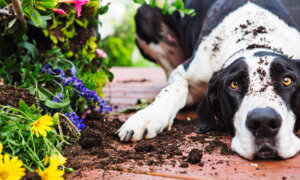Kim Brophey, with over two decades of experience, is using her background in applied ethology within the dog training industry to redefine how we perceive, talk about, and treat our canine companions, both as a society and as individuals.
As an applied ethologist, she uses the method of examining the specific effect that captivity and other human interventions have on various species living under direct human control.
She noted that most people don’t consider companion animals to be “captive” like farm and zoo animals are. With this approach, she aims to show that there is a much larger picture about our dogs’ behavior than is generally appreciated in our modern culture.
“I think we have been taught to think that dogs want to be our minions when they never signed up for that and we misunderstand the social affect as wanting to be obedient and deferential and be controlled when it’s really just social cooperative behavior that we’re seeing,” she said. “I just think it’s so important to revere dogs as sentient beings rather than think that they’re ours to do what we want with.”
Brophey is a certified dog behavior consultant through the International Association of Animal Behavior Consultants and a certified professional dog trainer through the Certification Council for Professional Dog Trainers.
She said that “obedience training,” with its methods of modifying behavior in dogs, has an emphasis on training to manipulate the expressions of behavior only and still leaves people without a true appreciation for the causes of behavior.
As an alternative, she teaches “Family Dog Mediation,” which is her model of integrated canine science—that all animal behavior is dictated by the interaction among four primary elements: learning, environment, genetics, and self (L.E.G.S.).
Breaking down further what L.E.G.S. means, she said that “learning” includes an animal’s experiences and education in life, “environment” includes the external conditions of an animal’s world, “genetics” includes the DNA that designed the animal inside and out, and “self” includes the internal conditions of a given animal, including health, age, sex, and personality.

(Courtesy of Kim Brophey)
She said these elements of L.E.G.S. are designed to work cooperatively for every animal’s benefit and survival, and each animal needs a unique individual recipe.
“Behavior problems” tell us that the L.E.G.S. of an animal is imbalanced, and modifying their behavior through training without a full appreciation for the complete picture of an animal’s L.E.G.S. can not only fail to get to the source of a problem, but can even further harm an animal psychologically, behaviorally, and emotionally, states her website.
She said that when we’re not getting a good dog, it’s not about dog training; it’s about what their needs are that aren’t being met.

(Courtesy of Kim Brophey)
“The shelter overpopulation is a great example of a symptom that is screaming for us to ask what is underneath that? Why on earth in a dog-loving culture would we have millions of dogs euthanized every year who are unwanted and living in shelters? Because the cycles of misunderstanding are not stopping. People go, ‘Well, that must’ve been a lemon.’ Then they go get another one and then repeat it again because the same fundamental flaws are at the heart of it,” Brophey said on episode 48 of the “Straight Up Dog Talk Podcast.”
For a deeper dive, Brophey has multiple resources, including her book “Meet Your Dog: The Game-Changing Guide to Understanding Your Dog’s Behavior”; her online canine genetic heritage software program The Dog Key; her TEDx Talk “The Problem With Treating a Dog Like a Pet”; her Family Dog Mediation service model; her YouTube documentary “The Dog’s Truth”; and the Family Dog Mediation Education Center, an online education platform for families and professionals. The L.E.G.S. Applied Ethology Dog Mediation Course is on sale 50 percent off during this month of November.
“I grew up as a kid being completely and totally obsessed with dogs and their behavior and our relationships with them. I grew up on Lassie and all that good stuff,” she said. “But then when I had my first experiences with dog training, I was like, that’s kind of weird; there’s kind of all this ego and control in it, and it seemed like it was kind of diminishing the dogs. I talk about that in my Ted Talk.”
She said we need the whole truth about dogs if we are to understand and help them in any meaningful way, and as such find resolutions to our frustrations as their housemates, partners, and friends.

(Courtesy of Kim Brophey)
She said positive dog training, even with its use of humane methods, positive reinforcement, and treats, is still shortsighted. Although it has good intentions, she said that it can still be coercive and manipulative in its ways of changing behavior, and the results it produces don’t necessarily serve the dog’s welfare.
Brophey said the dog learns things but doesn’t even know why it’s doing them, and there’s no function for its optimal wellness in it. We don’t normally think about these things as a culture, she said.
She said the dog industry followed the trend of pathologizing all behavioral problems and only provides treatment plans and medications to modify the behavior.
She said that idea isn’t serving a dog’s welfare because in that scenario we’re the puppeteer, they’re a blank slate, and it’s all about how we raise them and make them to be. She said that way doesn’t take into account that humans artificially selected dogs for their different perceptions and behaviors, and accounting for that is how we provide them with well-being.
For example, herding dogs have different needs, and it’s best to understand them to be their best stewards.
She said the cutting edge of animal welfare science that’s being applied currently in zoos internationally, particularly in Europe, is the model of “five domains.” The “five domains” looks at an animal’s quality of nutrition, environment, health, and behavior and then sees what mental state the animal is in as a result to determine quality of life. She said the way to measure that quality is by an animal’s diversity of behavior.
She said we need to look at whether animals are expressing a full range of who they are in the aspects of foraging, hazard avoidance, reproduction, and socializing to see if what we’re doing is creating a bigger wealth of expression or diminishing it, and that should be the measure for moving forward.
“Captivity doesn’t make sense,” she said.
She said it can be distressing and frustrating to a dog when it doesn’t get to do what it was bred and developed to do; for example, to run over mountains tracking a deer, or to go control livestock for eight hours a day, or to go get all the rats and varmints off the property.

(Courtesy of Kim Brophey)
She said that when we take a dog outside, it assumes it’s going to do one of the activities that humans bred and developed it to do, and when that doesn’t happen, it creates dysfunction. This results in most dogs becoming fearful, anxious, or reactive on a leash.
She added that if we take them out and we’re not hunting, and they’re not socializing or reproducing or anything along those lines, then the dog reacts like it’s time for hazard avoidance, putting it into a defensive mode—especially when encountering annoyed owners, other dogs walking by and acting defensive, and territorial urine signals from other dogs.
She said finding creative ways to take purposeful walks, such as to forage or to socialize, and creating rituals and patterns that a person and a dog can engage in together, can be a preventative measure and a treatment for a dog’s reactivity.

(Courtesy of Kim Brophey)
One of the most common kinds of complaints she said she gets from families is a dog’s behavior at the front door when people come over. She said the dog is either barking like crazy or snapping at ankles because it thinks that it’s an intruder, or jumping all over the guest.
“So we have this whole very loaded moment from the dog’s perspective,” she said.
She added that we should be looking at the situation from applied ethology, taking into account the dog’s perceptions to understand the underlying behavior.
“Let’s say they’re a dog that was bred to alert of intruders; maybe they’re a guardian breed or something like that and they’re bred to step up to the plate,” she said. “And so some stranger who the dog has never met knocks on the door, and here we are at the threshold of the territory line, and we open the door, and … this dog who was artificially selected for thousands of years to perceive and behave in very specific ways in that kind of a context … we just want the dog to not do it.”
To resolve the problem, the environment needs to be rearranged, she said, “so that you’re not sitting there at the front door trying to control your dog, telling your poor dear guest who’s just knocked on the door ‘He probably won’t bite you, just don’t make eye contact.’”
She said to use a baby gate or a leash on the back side of your family room, which gives the dog an off-duty location that has been set up for whenever someone knocks on the door.
She said to tell your dog that the visitor is a friend and it’s time for the dog to take a break with its favorite bone on the other side of the baby gate. Staying calm and having a plan creates predictability, signaling to the dog that you can take care of the situation, rather than the dog having to suppress its guardian behavior that it was developed to do.
She added that if you socialize your dog well enough, the dog will learn that the guest is not a threat and the dog can be let off the leash or come out from behind the baby gate.

(Courtesy of Kim Brophey)
She said another top complaint is puppy biting. She said all dogs are social animals, and puppies developmentally are super hyper social animals that need a lot of engagement. She said they’re figuring out how to be a dog; and while they play, communicate, and interact, they bite.
“If we just go at that with training and we say, ‘I’m going to reinforce you for not biting me and I’m going to punish you for biting me,’ or whatever that particular trainer’s approach is, we’re not meeting the need to wrestle things and bite things.”
She said small toys often don’t work because the puppy needs to interact with something that’s as big as or bigger than it so it feels like it’s socially roughhousing.
“If you provide young puppies with a life-size stuffed dog like these ‘Melissa & Doug’ kids’ toys type of stuffed dogs that are very realistic-looking,” she said, “they will play with it like it is a real dog 99 percent of the time.”
She said the puppy will roughhouse with it, chew on it, ambush it, and drag it around, and this interaction will cut down on the biting of people.
She said that a puppy knows it’s not real, but just like a young child with a doll or a stuffed animal, it goes through the motions as if it’s real. As children practice being young humans, puppies are practicing being young dogs.

(Courtesy of Kim Brophey)
Humans and dogs have lived together for tens of thousands of years, and for the majority of that time most dogs were not pets, she said. They were partners and companions helping people to hunt, farm, protect, and survive.
She added that the modern pet environment and lifestyle is difficult for most dogs, given their nature, instincts, and heritage. The behavior problems of modern dogs have created an unprecedented demand for professional dog trainers in hopes of fixing these problems. She said this is a red flag indicating the severity of the real underlying issues.
“Understanding, not more training, is the missing key to helping them,” she said.














